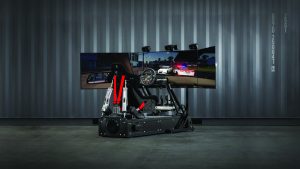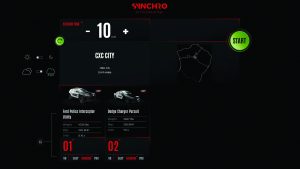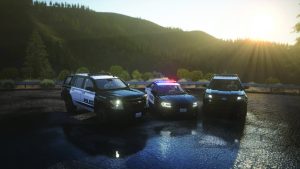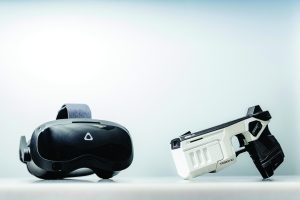A man spots a muscle car parked along the street. After checking inside, he notices a woman in the driver’s seat. The man opens the door, pulls the woman out, and drives away. Gaining speed, he passes a patrol vehicle heading in the opposite direction.
The patrol vehicle turns around, flashing its lights, and a high-speed chase ensues. As other police cars begin to join the chase, the man tries to evade them by turning onto a vacated street, bringing the vehicle to a stop, and running away. Before he can make it to the other end of the street, he realizes that he is surrounded by police and surrenders after hearing shouts to get on the ground.
Once the scene has been cleared, the trainee closes the scenario and removes their headset to review their actions with their peers, who have been casting the scene on a monitor.
While this scenario may sound like something from a video game, it is not completely dissimilar from today’s police training tactics. Virtual reality (VR) and simulation-based training have become frontrunners in the policing profession due to its accessibility and versatility—it can even be considered more economical.
Simulations

Every aspect of policing requires continual training. And while simulation training is not new to the profession, new advancements are being brought to the table so that more is offered than a basic screen setup. “Simulation provides immersive training that will assist officers with real-world scenarios, developing muscle memory and understanding their physical capabilities as well as the physics and capabilities of the tools they are using,” said Joel Flores, director of operations and business management at CXC Simulations (CXC).
For almost 29 years, CXC has been simulating real-world scenarios to create successful and practical training. While the company was a leader in the motorsport simulation industry for a long time, its government and policing division still had room to grow.

When approached by the U.S. Customs and Border Patrol to assist in developing a tactical driving training program, CXC couldn’t pass up the opportunity. The agency was looking for a solution that involved vehicle dynamics, performance driving, and scenarios that would assist them in getting their personnel ready for real-world situations. The Motion Pro II (MPII-T) Tactical was the result.

“Our goal is to elevate [emergency vehicles operations course] simulated training to a whole new level with high-fidelity physics and graphics systems, coupled with VR and a full physical feedback system,” said Flores. MPII-T is equipped with a full motion system, force feedback steering wheel, hydraulic pedal system, and tactile feedback devices that work in concert with CXC’s motion software, Synchro.
The proprietary software controls the MPII-T units, as well as the driving scenarios with an easy-to-use touchscreen user interface. Trainers can switch through scenarios in seconds, changing vehicles, maps, weather, time, and much more. When connected to the cloud, Synchro automatically updates to add new content and scenarios. The wraparound 4K screens are shown through high-performance displays to limit motion sickness.
The Multiplayer Tactical Driving Simulator System that is available to police includes two MPII-T simulators and a Synchro kiosk. Up to eight MPII-T units can be linked together for multiplayer training, creating a more realistic training experience.

Although they are new to the police market, CXC has adjusted their product based on conversations with agency leaders regarding the decrease in technical driving skills of new recruits.
“This corresponds with trends within the United States and other parts of the globe,” said Flores. “Studies have shown that Millennials and Gen Z are driving at much lower rates than their preceding generations.” When training with the MPII-T, young officers may have the tools to develop these skills to improve performance and increase both their own and the public’s safety.
Virtual Reality
Traditional training methods—flat-screen monitors, firing ranges, or role playing—can be costly, resource-intensive, and restrictive, often coming with limited range availability and significant logistical constraints. VR removes those restrictions by allowing officers to be fully immersed in a 360-degree scenario with the option to move about freely.
To meet officer needs, CEO Oliver Noteware knew that Street Smarts VR (SSVR) needed to be reliable, cost-effective, and functional. The system also needed to have a small enough footprint that allowed agencies to conduct the training even when space was limited. “We knew that it’s vital for training to be applicable to real-world situations,” said Noteware. “That’s why the only hardware our customers ‘wear’ is a headset.”
SSVR can be used to train individuals or teams of officers depending on the tasks. The capability to switch between lethal and nonlethal weapons has been a game changer, as trainees can become familiar with the effective utilization of both.
Instructors can choose from an expansive library of scripted and customized scenarios varying from mental health de-escalation to domestic violence calls to active shooter response. “We built this platform knowing that it wasn’t just about running an officer through a situation and ticking the box, but really enabling training outcomes that would translate to the real world,” said Noteware. SSVR gathers customer feedback to understand industry needs. The partnerships with organizations such as Texas State University’s Advanced Law Enforcement Rapid Response Training and Wilfrid Laurier University’s Mental Health Crisis Response Education and Applied Training ensure SSVR offerings are founded on the latest research and tailored to the evolving needs of policing professionals. This information drives the software and content updates that are delivered multiple times a year.
The system’s comprehensive review mode provides detailed after-action reports. Users can gather insights into performance metrics to evaluate what was done well or where there’s room for improvement.
Axon has been a major player in the VR realm since 2019, with the development of its Community Engagement Training. This training is focused on empathy and helping officers gain perspective on different types of situations that they would face when out in the community. The Community Engagement Training solution has 360-degree video and is filmed with live actors. With 25 modules (some even certified by the International Association of Directors of Law Enforcement Standards and Training), officers have a wide range of topics to select from.

Axon also developed Simulator Training. Where the Community Engagement Training is more like a video or movie (i.e., the user sees only what the camera sees), the Simulator Training content includes computer-generated imagery, making it more like a video game. There’s freedom of movement, and different environments or animations can be rendered.
“One of the key benefits for VR is that you can do as many repetitions as you want without having to pay for any consumable training cartridge costs,” said Thi Luu, Axon’s vice president and general manager of VR training products. Axon’s custom VR controllers mimic the true-to-life Taser 10 and Taser 7, which are built in partnership with HTC. LEDs are embedded into controllers that have the same form factor, size, and weight as Taser energy weapons. The same technology was used to create a handgun VR controller as well. “By offering both the handgun and Taser VR controller, we’re mimicking the tools that they have on their tool belt and letting them decide what is the appropriate amount of force to use depending on the scenario,” said Luu.

Each of these solutions come together in Axon’s newest development: Virtual Reality-Based Training Live Action (vRBT). These training courses, focused on crucial decision-making, combine live-action, 360-degree video with interactive computer-generated imagery elements for the use of the VR handgun and Taser controllers.
Conclusion
Consistent training is a major part of the policing profession. When traditional training fails, VR solutions are cost-effective, realistic alternatives. The cutting-edge technology can even act as a recruitment tool.
The adage “practice makes perfect” is personified in VR and simulation training solutions, as they offer unlimited opportunities for officers to hone their skills.
Notes:
1Joel Flores (director of operations & business management, CXC Simulations), email interview, April 29, 2024.
2Oliver Noteware (chief executive officer, Street Smarts VR), email interview, May 3, 2024.
3Thi Luu (vice president and general manager of VR training products, Axon), phone interview, May 2, 2024.
Source ListPlease click on the companies’ names to go to the companies’ websites. |
|
|
CBF Forensics |
|


